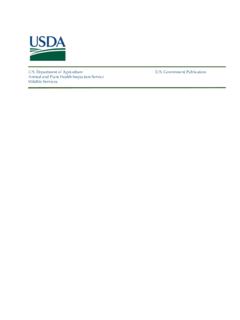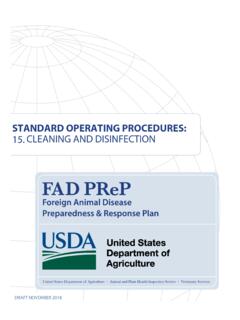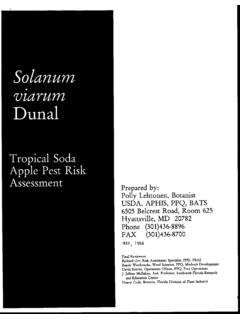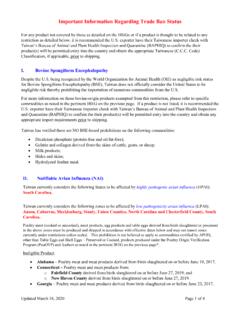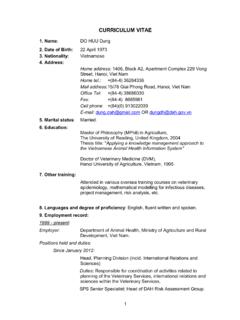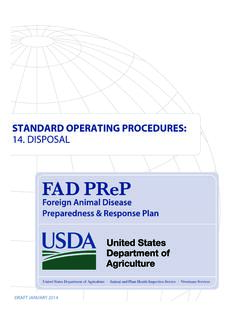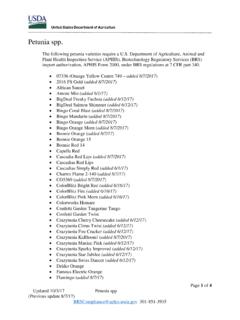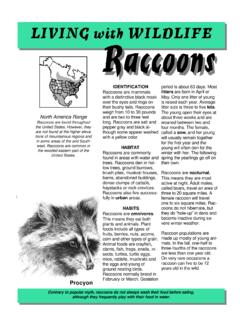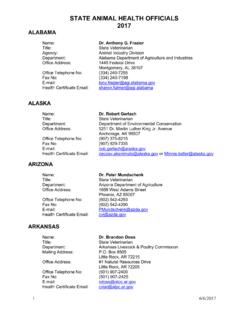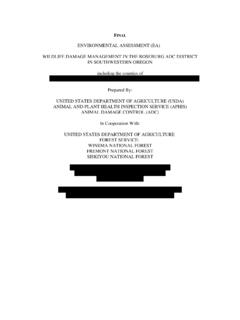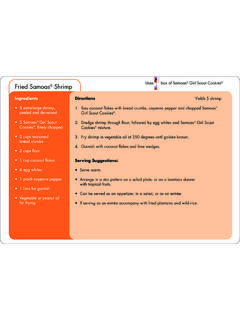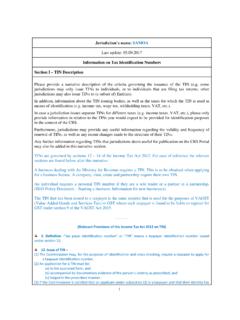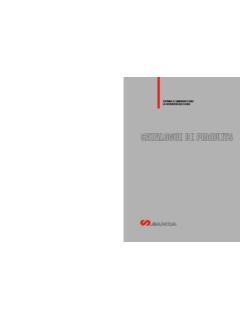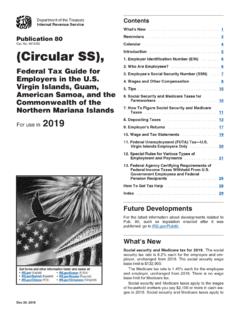Transcription of Invasive Myna Control in American Samoa - USDA-APHIS
1 Invasive Myna Control in American Samoa Michael L. Avery usda APHIS Wildlife Services, National Wildlife Research Center, Gainesville, Florida John D. Eisemann usda APHIS Wildlife Services, National Wildlife Research Center, Fort Collins, Colorado ABSTRACT: The common myna is an Invasive species in Florida, Hawaii, and in numerous other locations around the world. It is native to southern and south-east Asia. Common mynas are considered pests to fruit crops in many locales, and they are predators on eggs of other birds. Since their introduction to American Samoa in the 1980s, mynas have become the most frequently observed avifauna in developed areas in the country. The American Samoa Department of Marine and Wildlife Resources (DMWR) is concerned that expanding myna populations will exert competitive pressures on native species such as the Samoan starling and white-collared kingfisher. Additionally, the mynas are increasingly becoming social nuisances through nesting, foraging, and vocalization behaviors.
2 The government and general population of American Samoa would like to eradicate these birds before populations are too large to Control . In partnership with DMWR, we conducted trials with captive mynas to determine sensitivity to the avian toxicant DRC-1339, and to evaluate a potential baiting strategy for applying this toxicant on American Samoa to reduce myna populations. KEY WORDS: Acridotheres tristis, American Samoa , common myna, DRC-1339, Invasive species, LD50, lethal Control , toxic bait Proc. 26th Vertebr. Pest Conf. (R. M. Timm and J. M. O'Brien, Eds.). Published at Univ. of Calif., Davis. 2014. Pp. 140-144. INTRODUCTION there are familial trends in the sensitivity of birds to The common myna (Acridotheres tristis) is an DRC-1339 (Eisemann et al. 2003). Mynas and starlings Invasive species in Florida, Hawaii, and in numerous are in the family Sturnidae. They are thus expected to be other locations around the world. It is native to southern very sensitive to DRC-1339.
3 The LD50 for the European and south-east Asia. Common mynas are considered starling (Sturnus vulgaris) is mg/kg, with 95%. pests to fruit crops in many locales and they are predators confidence interval of mg/kg (DeCino et al. on eggs of other birds (Dawson and Bull 1970, Byrd 1966). Although we suspect that mynas are very sensi- 1979, Nagle 2006). Mynas were introduced in American tive to DRC-1339, this has never been formally Samoa in the 1980s, and they are now found commonly documented. In the first part of this study, we determined throughout developed areas in the country (Chen 2013). the toxicity of DRC-1339 to mynas. We then developed While the actual threat to ecological systems is currently and tested baits for effectively delivering the toxicant. unknown, the American Samoa Department of Marine and Wildlife Resources (DMWR) is concerned that METHODS. expanding myna populations will exert competitive Acute Oral Toxicity pressures on native species such as the Samoan starling We applied the up-and-down dosing procedure (UDP).
4 (Aplonis atrifusca) and white-collared kingfisher as per the revised Environmental Protection Agency (Todiramphus chloris). Additionally, the mynas are (EPA) acute oral toxicity testing guidelines (OPPTS. increasingly becoming social nuisances through nesting, Acute Oral Toxicity). These guidelines foraging, and vocalization behaviors. The government incorporate alternative test methods which provide for and general population of American Samoa would like to enhanced animal welfare by reducing the number of eradicate these birds before populations are too large to animals required during laboratory testing. According to Control . the EPA, the new Acute Oral Toxicity guideline calling There have been many efforts to eradicate Invasive for use of the revised Up-and-Down Procedure should be myna populations (Parkes 2012). The techniques used used for acute oral toxicity studies initiated after have varied, but mainly include poisoning with DRC- December 2002.
5 1339, trapping, and shooting (Feare 2010, Canning 2011, Implementation of the UDP requires selection of an Grarock et al. 2014). Some small colonizing populations initial dose. The guidelines state: The first animal is have been eradicated using trapping alone, but in general dosed a step below the toxicologist's best estimate of the a combination of methods is employed. After reviewing LD50. For the common myna, our best estimate of the case studies of myna Control efforts, Parkes (2012) LD50 is mg/kg, based on starling toxicity (DeCino et concluded that sequential application of poisoning, al. 1966). In the test guidelines, several possible dose trapping, and shooting, in that order, comprise the most progressions are specified. In dose series 3, one step appropriate approach. below our best estimate of mg/kg is mg/kg. DRC-1339 (active ingredient 3-chloro-p-toluidine Thus, we selected mg/kg as our initial dose. The HCL; CAS number 7745-89-3), commercially known as progression of doses (mg/kg) in series 3 is , , Starlicide , is the avian toxicant usually associated with , , , , and (USEPA 2002).
6 Thus, if the myna Control programs. There is some evidence that first test bird survived the initial dose of mg/kg, then 140. the second bird would receive a dose one step higher, and in the spill bowl. We also weighed the food mg/kg. If the first bird died from the initial dose, then the remaining in the maintenance cup and spill bowl at this second bird would be dosed one step lower, at time. We then gave each bird a bowl of daily mg/kg. We followed the dose progression until we maintenance food. On Day 2, we repeated the procedure reached 1 of 3 stopping criteria specified in the test except that the 10 birds assigned to the treatment group guidelines [USEPA 2002, section (3) (iv)]. received cooked white rice treated with DRC-1339. We randomly selected test birds from the wild-caught Thereafter, all 17 birds received only maintenance food (near Homestead, FL) captive population at the NWRC and water. research field station in Gainesville, FL. We placed test To estimate each bird's daily consumption, we birds in individual test cages (45 cm on each side) for at subtracted the amount of food remaining in the rice or least 14 days prior to dosing to allow for acclimatization.
7 Maintenance food cup and the amount of spillage On the day of dosing, we removed the test bird's food at retrieved from the respective spill bowl from the weight 0700 (water was not withheld). Then, at approximately of the food in the corresponding Control cup. Any 0900, we weighed the designated test bird, determined the calculated values <0 were assumed to be 0. We used appropriate dose, and administered the test substance. one-way analysis of variance to examine differences in We used a total of 6 birds in this test. We applied one- bait consumption and loss of body mass between birds way analysis of variance (Minitab 2007) to examine exposed to treated bait and those in the untreated Control differences in body mass and amount of toxicant ingested group (Minitab 2007). between birds at the 2 dose levels tested. To administer a dose, one person held the bird steady Preparation of Rice Bait and a second person opened the bill using a hemostat, the Based on information provided by colleagues in tips of which were covered by short segments of plastic American Samoa (Josh Seamon, DMWR, Honolulu, HI, tubing.)
8 The first person administered the dose by unpubl.), we selected cooked white rice as the bait. We inserting the end of a blunt 17-gauge gavage tube into the prepared rice (350 g rice plus 400 ml water and 5 ml bird's mouth and carefully down the esophagus, and then canola oil) in a standard rice cooker. When the rice was slowly releasing the aqueous solution from a 1-ml cooked, we rinsed it with cold water to remove starch and syringe. After dosing, we returned each bird its individ- reduce stickiness. The rice air-dried 4 hours in an air- ual test cage. conditioned lab. We placed then put the cooked rice in a closed container and refrigerated it overnight. The next Cage Test for Bait Efficacy day, when we weighed out rice for the feeding trial, we Test Procedure also removed ~200 g of rice, sealed it in a plastic bag, and We followed the EPA test guideline for determining refrigerated it for chemical analysis. efficacy of vertebrate Control agents, avian toxicants To prepare treated rice, there was one extra step: after (USEPA 1982).
9 Common mynas in our captive the rice was air-dried, and before it was refrigerated population were caged individually ( ) in overnight, we placed 400 g of the air-dried rice in a an outdoor, roofed aviary. From the 17-bird captive rotating mixer, and we added 40 ml of the aqueous population, we randomly assigned 10 birds to the treated toxicant solution (100 mg DRC-1339 in 50 ml distilled group. The remaining 7 birds comprised the untreated water) as the rice rotated slowly in the mixer. We also group. added 5 ml of canola oil to the rotating rice to aid in One week prior to the start of the feeding trial, we adherence of the toxicant to the rice particles. After 15. weighed each bird to determine its initial body mass. We minutes, we stopped the rotating mixer and transferred removed each bird from its cage, placed it securely in a the treated rice to a closed container and refrigerated it cloth bag, and weighed the total (bird plus bag) on an overnight.
10 The next day, when we weighed out treated electric balance (Mettler P2010, Mettler Electronics rice for the feeding trial, we also collected 6 samples of Corp., Anaheim, CA). We recorded the total weight on a ~20 g each from the container. We sealed the 6 samples data sheet, and then released the bird back into its cage. in plastic bags and refrigerated them for chemical analysis We then weighed the bag separately and recorded that on to determine DRC-1339 content. the data sheet. The bird's body mass was the difference between the two values. We repeated this procedure for Observations of Test Subjects each of the 17 test birds. On Days 1 and 2, we monitored the behavior of 4. On Test Day 1, we removed the previous day's randomly chosen birds in the treatment group at their maintenance food from each cage at 0700. At ~0900, in food cups (0900-1200) with surveillance cameras. On each cage, we presented 25 g of untreated cooked white Day 2, after the treated bait was removed, we adjusted the rice in one food cup, and we provided a second cup cameras so that all of the birds in the treatment group containing 25 g of fresh maintenance diet.
